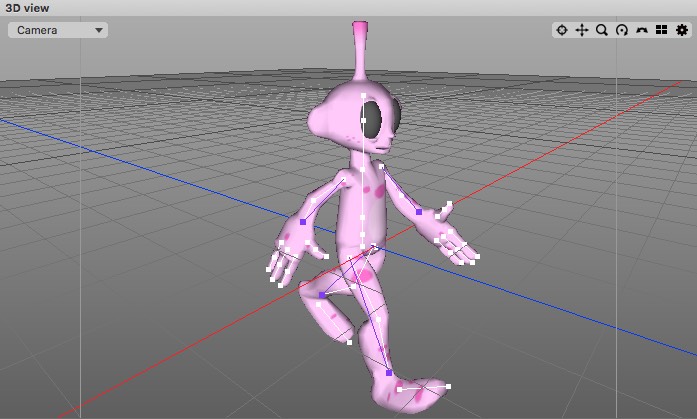3D View
The 3D View makes up the main portion of the Cheetah3D window. It shows you an OpenGL preview of your scene, and supplements it with guidelines, handles and matrices that allow you to modify your scenes layout.

A typical 3D View, showing a rigged character.
The position and rotation of the active camera can be changed conveniently by the small icon bar above the 3D view. These icons only effect the active camera. The functions of these icons from left to right are:
- select the camera projection
- select different view styles (see below)
- focus on selected object
- move the camera to the left, right, up and down
- zoom camera in and out along the viewing direction
- rotate camera around the selected object
- rotate camera to the left, right, up and down
- change into the quad view mode
The camera position can also be changed by pressing a key combination + dragging the mouse in the 3D view:
- If you have a one button mouse:
- alt + mouse drag: rotate camera around the selected object
- alt + command + mouse drag: move camera in and out
- alt + ctrl + mouse drag: move camera left, right, up and down
- alt + shift + mouse drag: turn camera
- If you have a three button mouse:
- alt + left mouse button drag: rotate camera around the selected object
- alt + middle mouse button drag: move camera left, right, up and down
- alt + right mouse button drag: zoom camera in and out
Using the "Style" menu you can set some OpenGL properties of the 3D view:
- backface culling: Turn on and off OpenGL backface culling. When turned on only polygons which face the camera are drawn, whilst polygons facing away are not.
- wireframe: Turn this on to draw the whole scene in wireframe.
- antialiasing: Turn this on to activate line antialiasing, should your garphics card support it.
- light both sides: Turn this on if both sides of all polygons should be lit, not just the ones that face the camera.
When you click inside the 3D View, what happens depends largely on which tool is currently active - you can see this by looking at the lower portion of the Property Editor. Mostly, you'll use the 3D View to position objects (in which case, you would select an object from the Object Browser, choose the Transform tool, and click and drag on one of the transform widgets on the Transform guide shown). However, if you're working in Point, Edge or Polygon mode, you may also click in the 3D View to select parts of objects to edit.
You can also move the camera around by clicking and dragging. If you hold down the Alt key, the camera will rotate around a central point.
Note
Since the 3D View is an OpenGL preview, some advanced features do not show up, such as complex material properties. You must render a scene using the Renderer before these effects will be visible.